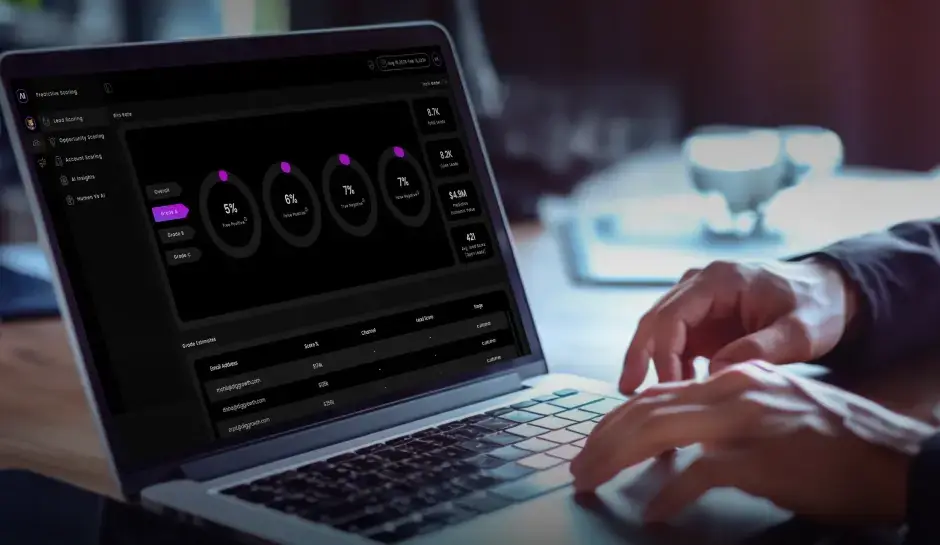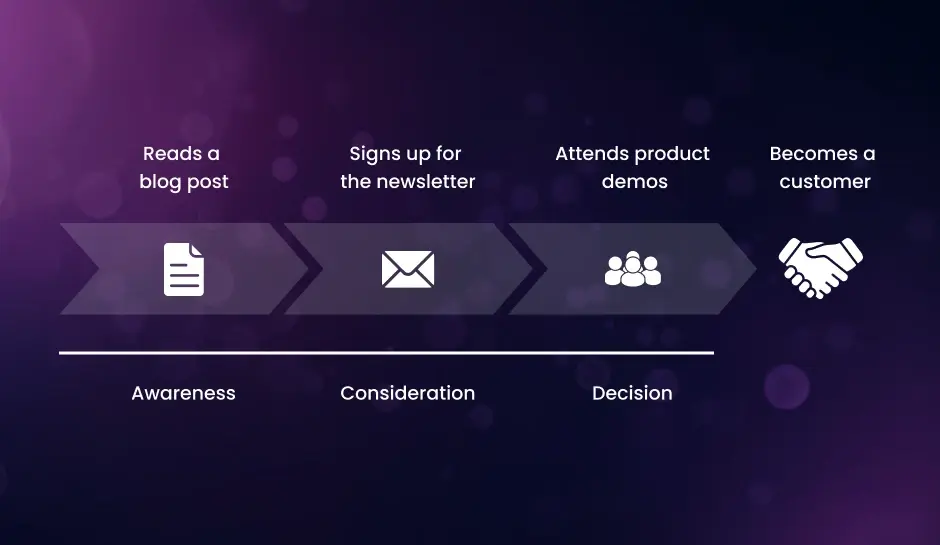
5 Key Metrics Every CMO Should Be Tracking
To see how well their marketing avenue is doing, CMOs need to track metrics that are tied directly to their business goals. In this blog post, we have covered five metrics every CMO should be tracking. Read on.
In today’s data-driven world, tracking metrics is an essential aspect of any business’s success. For marketers and CMOs, tracking metrics is particularly important to measure the effectiveness of their marketing campaigns and ensure they are achieving their business objectives. However, it’s not just about tracking any metrics but rather tracking the right metrics.
Tracking the right metrics can provide invaluable insights into the performance of your marketing campaigns and help you optimize them for better results. And it’s also important to avoid falling into the trap of tracking vanity metrics, which may look good on paper but do not provide any real value and can prevent you from making true data-driven decisions.
Instead, it’s important to focus on metrics that are directly tied to your business goals and that provide actionable insights. In this blog post, we will discuss the five key metrics every CMO should be tracking and provide detailed tips on how to increase each one.
Return on Investment (ROI)
Return on Investment (ROI) is a financial metric that measures the profitability of an investment by calculating the ratio of the investment’s profit to its cost. In marketing, ROI is calculated by subtracting the cost of the marketing campaign from the revenue generated by the campaign and dividing the result by the cost of the campaign.
As a CMO, tracking ROI is crucial because it provides insight into the profitability of your marketing campaigns. If your campaigns are generating a positive ROI, you know that your marketing efforts are paying off. Conversely, if your campaigns are generating a negative ROI, it’s time to re-evaluate your marketing strategy.
To improve ROI, focus on optimizing your marketing campaigns. This includes targeting the right audience, creating compelling content, and optimizing your ad spend. Here are a few tips to help you improve ROI:
- Set clear goals
- Target the right audience
- Create compelling content
- Optimize your ad spend
Before launching any marketing campaign, set clear goals that are specific, measurable, and achievable. This will help you effectively track your progress and see how far you’ve come.
Make sure you are targeting the right audience for your campaign. Use data and analytics to understand your target audience’s behavior and preferences.
Draft content that resonates with your target audience. Use storytelling, humor, or other tactics to create engaging and memorable content.
Use data and analytics to optimize your ad spend. Focus on channels and campaigns that generate the most ROI.
Customer Acquisition Cost (CAC)
Customer Acquisition Cost (CAC) measures the cost of all the efforts you put towards acquiring a new customer. It’s calculated by dividing the total cost of sales & marketing by the number of new customers acquired.
Tracking CAC is important for CMOs because it helps determine the effectiveness of their sales and marketing campaigns. If your CAC is too high, it may be time to reassess your customer acquisition strategy.
To reduce CAC, focus on increasing the effectiveness of your sales and marketing campaigns. This includes targeting the right audience, creating engaging content, and improving your sales process. Here are a few tips to help you reduce CAC:
- Identify and prioritize the right audience
- Try affiliate partner programs
- Work on customer retention:
For CMOs, it’s important to channel resources toward the right audience. Identify and outline the target audience that actually has a need for your product/services. For instance, a website visitor that may have signed up for your blog or newsletter six months ago may not necessarily benefit from the content you are creating to engage a new website visitor. In this case, creating specific buyer personas and clearly defining the line between new, somewhat new, old, and somewhat old prospects, will help you in ultimately reducing CAC.
These are programs where your affiliates use their influence to help you engage with potential clients. Affiliate partner programs are an effective way to lower CACs as you only pay your affiliates a percentage-based commission after a customer buys from you, as opposed to the full cost of acquiring a customer.
The average repeat customer spends
67% more in the 31st to 36th month of their relationship
with a business than in 0-6 months. It’s no secret that it costs way more to acquire a new customer than to retain an existing one. Therefore, it’s important to figure out what you can do better in terms of your product or service to continue bringing value to your customers, post the point of sale.
Conversion Rates
Conversion rates measure the percentage of visitors to your website or landing page that take a specific action, such as making a purchase or filling out a form. Tracking conversion rates is important because it helps you understand how effective your website or landing page is at converting visitors into customers.
To improve conversion rates, focus on improving and optimizing your website or landing page. This includes creating compelling content, optimizing your user experience, and improving your call-to-action. Here are a few tips to help you improve your conversion rates:
- Shorten the forms on your pages
- Optimize your user experience
- Improve your call-to-action
- A/B testing
If you have a long form, website visitors could either be hesitant to fill it or just won’t have the time to. When you shorten your forms, however, it builds trust among your audience that you don’t need a whole lot from them and are considerate of their time as well.
Make sure your website or landing page is user-friendly, easy to navigate, and visually appealing. Ensure that the page loads quickly and is optimized for mobile devices as well.
Make your call-to-action clear and compelling. Use actionable language and visually-appealing design elements to encourage visitors to take action.
Use A/B testing to experiment with different variations of your website or landing page. Test different headlines, copy, images, and calls-to-action to see what works best.
Customer Lifetime Value (CLV)
Customer Lifetime Value (CLV) measures the total amount of revenue a customer will generate for your business over their lifetime. It is calculated by multiplying the average value of a customer’s purchase by the number of purchases they will make in a lifetime.
Tracking CLV is important for CMOs because it helps you understand the long-term value of your customers. If your CLV is too low, it may be time to reassess your customer retention strategy.
To increase CLV, focus on building strong relationships with your customers. This includes providing exceptional customer service, offering loyalty programs and incentives, and encouraging repeat business. Here are a few tips to help you increase CLV:
- Provide unmatchable customer service
- Offer loyalty programs and incentives
- Cross-selling and upselling
- Increase customer engagement
Make your customers feel valued and appreciated. Respond to their questions and concerns promptly and provide personalized support when necessary.
Encourage repeat business by offering loyalty programs, incentives, and special offers to your most valuable customers.
Encourage customers to purchase additional products or services by cross-selling and upselling. Recommend related products or services based on their purchase history and preferences.
Keep your customers engaged with your business by providing relevant content, personalized recommendations, and social media engagement.
Social Media Reach and Engagement
Social media reach and engagement measures the number of people who have seen or interacted with your social media content. Tracking social media reach and engagement is important because it helps you understand how effectively your content is resonating with your target audience.
To increase social media reach and engagement, focus on creating engaging and shareable content. This includes using compelling visuals, storytelling, and user-generated content. Here are a few tips to help you increase social media reach and engagement:
- Use compelling visuals
- Use storytelling
- Use user-generated content
- Engage with your audience
Use high-quality visuals, such as images and videos, to capture your audience’s attention and encourage them to engage with your content.
Create engaging and memorable content that resonates with your audience with the power of storytelling. Use real-life examples, testimonials, or success stories to make your content more relatable.
Encourage your audience to create and share their own content about your brand. This can help increase social media reach and engagement and build a sense of community around your brand.
Respond to comments and messages promptly and engage with your audience on social media. This will help build trust and credibility with your audience.
Understanding the Role of a CMO
A Chief Marketing Officer (CMO) plays a vital role in any organization’s marketing functions and strategies. They are responsible for overseeing and managing all marketing activities to help achieve business goals and drive revenue generation and growth. Let’s delve deeper into the responsibilities and duties of a CMO.
Responsibilities and duties of a Chief Marketing Officer
CMOs are responsible for developing and executing comprehensive marketing strategies that align with the overall business objectives. They must establish clear marketing goals and objectives and ensure their teams are working towards achieving them.
Additionally, CMOs must stay updated with market trends, consumer behavior, and competitor analysis. They need to ensure that their organizations are at the forefront of innovation and maintain a competitive edge.
Furthermore, CMOs are responsible for managing the marketing budget and allocating resources effectively to maximize return on investment. They collaborate with different teams within the organization, including sales, product development, and finance, to ensure marketing efforts are aligned with the overall business strategy.
How CMOs are responsible for driving marketing strategies and achieving business goals
One of the critical roles of a CMO is to develop and execute marketing strategies that drive business growth. They analyze market data, consumer insights, and industry trends to identify opportunities for brand awareness, customer engagement, and lead generation.
CMOs work closely with their teams to implement marketing campaigns, create compelling content, and optimize digital marketing efforts. They leverage various channels such as social media, email marketing, search engine optimization, and traditional advertising to reach the target audience and achieve marketing objectives.
Additionally, CMOs monitor and evaluate the performance of marketing campaigns using key performance indicators (KPIs) and analytics. They analyze data to assess the effectiveness of marketing efforts, identify areas for improvement, and make data-driven decisions to optimize marketing strategies.
Emphasize the importance of CMOs’ role in revenue generation and growth
CMOs play a crucial role in revenue generation and business growth. They focus on building brand equity, increasing market share, and enhancing customer loyalty. By effectively positioning the company’s products or services in the market, CMOs drive sales and contribute to the overall revenue and profitability of the organization.
Moreover, CMOs are responsible for developing pricing strategies and identifying new market opportunities to drive revenue growth. They analyze customer insights, market trends, and competitive landscapes to identify untapped markets or areas for expansion.
Overall, the role of a CMO is integral to the success of any organization’s marketing efforts. They are responsible for driving marketing strategies, achieving business goals, and contributing to revenue generation and growth.
The Need for Tracking in Marketing
Tracking marketing activities and performance is essential for any CMO looking to excel in their role. By monitoring and measuring various metrics, CMOs can gain valuable insights that inform their decision-making processes and drive business success.
One of the key benefits of tracking is the ability to assess the effectiveness of marketing campaigns and initiatives. It allows CMOs to determine which strategies and tactics are working and which ones may need adjustment. By closely monitoring campaign performance, CMOs can make data-driven decisions that optimize marketing efforts and maximize returns.
Effective tracking also provides CMOs with the means to identify areas of improvement and measure progress towards marketing goals. By analyzing data on customer behavior, campaign engagement, and conversion rates, CMOs can identify patterns and trends that guide their strategies. This enables them to allocate resources more efficiently, target the right audience, and deliver personalized experiences that resonate with customers.
Furthermore, inadequate tracking can have severe implications for marketing strategies and overall business growth. Without accurate data and insights, CMOs are essentially operating in the dark, making decisions based on intuition rather than evidence. This can lead to ineffective campaigns, wasted resources, and missed opportunities. In today’s competitive landscape, where marketing budgets are scrutinized, CMOs simply cannot afford to overlook the need for tracking.
In conclusion, tracking plays a crucial role in the success of a CMO and their marketing initiatives. By leveraging data and insights, CMOs can make informed decisions, optimize strategies, and achieve business growth. Embracing tracking as an integral part of their role empowers CMOs to drive meaningful results and stay ahead in the ever-evolving marketing landscape.
Key Metrics for CMO Tracking
Overview of essential metrics to track for CMOs: In order for CMOs to effectively measure and optimize their marketing strategies, it is crucial to identify and track key metrics that align with organizational goals.
- Marketing analytics
- Marketing performance tracking
- Customer journey tracking
- Campaign tracking
- Marketing ROI tracking
- Lead generation tracking
- Attribution modeling
- Digital marketing tracking
- Performance metrics
- Marketing technology stack
Understand the power of data-driven insights: By leveraging marketing analytics, CMOs can gain valuable insights into consumer behaviors, market trends, and campaign performance, enabling them to make data-driven decisions and optimize marketing efforts.
Analyzing the effectiveness of marketing campaigns: CMOs need to track the performance of their marketing campaigns to evaluate their effectiveness in reaching the target audience, generating leads, and driving conversions.
Monitoring customers’ interactions and touchpoints: Understanding the customer journey is essential for CMOs to identify pain points, optimize touchpoints, and provide a seamless experience to customers throughout their interactions with the brand.
Assessing the success of individual marketing initiatives: CMOs should track the performance of individual marketing initiatives to determine their impact on overall marketing goals and make data-informed decisions for future campaigns.
Evaluating the return on investment for marketing efforts: CMOs need to measure the ROI of their marketing efforts to determine the profitability of campaigns, allocate resources effectively, and justify marketing budgets.
Monitoring the effectiveness of lead generation strategies: By tracking lead generation metrics, CMOs can assess the performance of their strategies, identify areas of improvement, and optimize lead nurturing efforts to generate qualified leads.
Determining the impact of different marketing channels on conversions: CMOs should employ attribution modeling techniques to understand which marketing channels contribute the most to conversions, allowing them to allocate resources and optimize their marketing mix accordingly.
Tracking online marketing activities and performance: Given the significant role of digital marketing in today’s business landscape, CMOs must monitor the performance of online marketing campaigns, assess website traffic, engagement, and conversion rates, and optimize digital marketing strategies as needed.
Identifying the key performance indicators (KPIs) for CMOs: CMOs need to establish relevant KPIs to gauge the success of their marketing initiatives, such as customer acquisition rate, customer lifetime value, marketing-qualified leads, and return on marketing investment.
Discussing the tools and technologies for efficient tracking: CMOs should stay updated on the latest marketing technologies, such as marketing automation platforms, CRM systems, and analytics tools, to streamline their tracking processes and enhance overall marketing performance.
Leveraging CMO Tracking for Business Success
CMOs play a critical role in driving a company’s marketing initiatives. They are responsible for developing and implementing strategies that help achieve business goals. CMO tracking is an essential tool that can help CMOs make informed decisions and drive successful outcomes for their organizations.
How CMOs can utilize tracking data for effective decision-making
Tracking data allows CMOs to monitor the performance of various marketing activities, campaigns, and channels. By analyzing this data, CMOs can identify what is working and what is not, enabling them to make informed decisions. For example, if a particular marketing channel is not generating the desired results, a CMO can use tracking data to identify the problem and allocate resources elsewhere.
Enhancing marketing strategies based on tracked insights
Tracking data provides valuable insights into customer behavior, preferences, and engagement levels. CMOs can leverage this data to refine their marketing strategies and tactics. For instance, if tracking data shows that a specific demographic is more responsive to certain messaging or offers, CMOs can tailor their marketing efforts to cater to that segment, leading to improved engagement and conversion rates.
Optimizing marketing campaigns and allocation of resources
CMO tracking enables CMOs to optimize marketing campaigns by understanding which initiatives are driving the best results. By identifying the most effective tactics and channels, CMOs can allocate resources accordingly, ensuring maximum impact and ROI. Moreover, tracking data can help identify underperforming campaigns, enabling CMOs to make necessary adjustments or reallocate resources to achieve better outcomes.
Improving customer acquisition efforts through data-driven insights
Tracking data provides invaluable insights into the customer acquisition process. CMOs can use this data to identify the most effective customer acquisition channels, campaigns, and messaging. By understanding what resonates with potential customers, CMOs can optimize their acquisition efforts, resulting in higher conversion rates and improved customer acquisition costs.
Measuring and maximizing marketing ROI using tracking data
Tracking data allows CMOs to measure the ROI of their marketing activities accurately. By tracking key metrics and analyzing data, CMOs can identify the marketing initiatives that generate the highest returns. This enables them to make data-driven decisions and allocate resources to initiatives that maximize ROI, ultimately driving business success.
Best Practices for CMO Tracking
Tracking the performance and effectiveness of your marketing efforts is crucial for a CMO. By implementing best practices for CMO tracking, you can ensure that your tracking efforts are accurate, reliable, and contribute to the overall success of your business. Here are some key best practices to consider:
- Establishing a comprehensive tracking system
- Setting clear goals and objectives for tracking efforts
- Choosing suitable tracking tools and technologies
- Ensuring data accuracy and reliability
- Regularly analyzing and reviewing tracking data
- Collaborating with other departments for holistic tracking and reporting
Create a tracking system that captures all relevant data points and metrics. This could include website analytics, conversion tracking, campaign tracking, and customer engagement metrics.
Clearly define what you want to achieve with your tracking efforts. This will help you identify the metrics that matter most to your business and focus your tracking efforts accordingly.
Select tracking tools and technologies that align with your specific tracking needs. Consider the scalability, ease of use, and integration capabilities of the tools you choose.
Regularly audit and validate your tracking data to ensure its accuracy and reliability. Implement data quality controls and procedures to minimize errors and discrepancies.
Continuously analyze and review your tracking data to gain insights and identify areas for improvement. Regularly communicate these findings to relevant stakeholders.
Work closely with other departments, such as sales and finance, to ensure that your tracking efforts are aligned with overall business objectives. Collaborate on tracking and reporting initiatives to achieve a holistic view.
Conclusion
Tracking key metrics is essential for CMOs to ensure that their marketing campaigns are effective in achieving their business goals. In this blog post, we discussed the five key metrics every CMO should be tracking and provided detailed tips on how to increase each one.
By tracking ROI, CAC, conversion rates, CLV, and social media reach and engagement, CMOs can make data-driven decisions and optimize their marketing campaigns for maximum impact.
Are All Your Marketing Initiatives Data-Driven? Let’s find out!
If you want to be the CMO who always has a holistic view of their marketing activities, check out DiGGrowth, an AI-driven, no-code marketing analytics platform to measure your marketing effectiveness. Alternatively, please feel free to write to us at info@diggrowth.com and we’ll get right back to you.
Ready to get started?
Increase your marketing ROI by 30% with custom dashboards & reports that present a clear picture of marketing effectiveness
Start Free Trial
Experience Premium Marketing Analytics At Budget-Friendly Pricing.

Learn how you can accurately measure return on marketing investment.
Additional Resources
The Future of Marketing: How Predictive Lead and Account Scoring is Changing the Game
Can we, in this incredible marketing landscape driven...
Read full post postCloud Wars: A Comparative Analysis of Leading Cloud Vendors
How many companies are using cloud computing? Around...
Read full post postContent Marketing Attribution: Tracking Content Impact Across the Customer Journey
So, you've poured your heart into crafting the...
Read full post postFrequently Asked Questions
Tracking metrics is crucial for marketers and CMOs as it allows them to measure the effectiveness of their marketing campaigns and ensure they are achieving their business objectives. It provides valuable insights into campaign performance and helps optimize them for better results.
To improve ROI, here are some tips:
1: Set clear goals before launching any marketing campaign to effectively track progress.
2: Target the right audience by using data and analytics to understand their behavior and preferences.
3: Create compelling content that resonates with the target audience.
4: Optimize ad spend by using data and analytics to focus on channels and campaigns that generate the most ROI.
CMOs track Customer Acquisition Cost (CAC) to determine the effectiveness of their sales and marketing campaigns. Tracking CAC helps identify if the cost of acquiring new customers is reasonable or if adjustments need to be made to the customer acquisition strategy.
To reduce CAC, consider the following tips:
1: Identify and prioritize the right audience by creating specific buyer personas.
2: Try affiliate partner programs to lower CAC by paying affiliates a commission based on customer purchases.
3: Work on customer retention to bring value to existing customers and reduce the need for acquiring new ones.
To improve Conversion Rates, marketers can focus on:
1: Shortening forms on pages to build trust and respect the audience's time.
2: Optimizing the user experience by ensuring the website or landing page is user-friendly, easy to navigate, and visually appealing.
3: Improving the call-to-action by making it clear, compelling, and visually appealing.
4: Conducting A/B testing to experiment with different variations and determine what works best for increasing conversions.
CMOs should track Customer Lifetime Value (CLV) to understand the long-term value of customers. Tracking CLV helps identify if the value customers bring over their lifetime is sufficient and if customer retention strategies need improvement.
To increase CLV, consider the following tips:
1: Provide exceptional customer service to make customers feel valued and appreciated.
2: Offer loyalty programs and incentives to encourage repeat business.
3: Cross-sell and upsell by recommending related products or services based on purchase history and preferences.
4: Increase customer engagement by providing relevant content, personalized recommendations, and social media interaction.
Tracking social media reach and engagement is important as it helps understand how effectively content is resonating with the target audience. It provides insights into the success of social media strategies and allows for adjustments to improve audience engagement.
 Manreet Khara
Manreet Khara 

